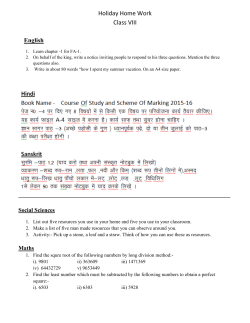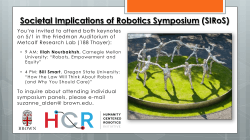
2015 Hayes STEM Robotics Invitational
2015 Hayes Freedom Robotics STEM Invitational (rev. 2.0) Wednesday, June 3 Hayes Freedom High School 1:30 p.m – 5:30 p.m. (( Thank you Olympia School District )) Team Guidelines Teams may compete in any or all events. Teams may have up to two entries in each event; one for the Red Bracket and one for the Blue Bracket Rookie and veteran teams will compete in separate divisions, running concurrently on different events. A rookie team consists entirely of students with less than one semester of STEM Robotics by June 1. FLL veterans are considered veterans for this event too. Unique robots (provided they meet the guidelines below) may be used for each event. Teams must confirm their intended number of entries in each event by Tuesday, May 26 so randomized brackets can be created in advance of the competition. Event Procedures The three events (described below) will be run consecutively for each division (rookie and veteran) to allow all participants to see all events and facilitate individuals competing in more than one event. Teams are responsible for tracking their progress through the red and blue brackets and having themselves in queue for their next match. There will be no runners or announcements for queuing. The brackets will be projected on screens and teams are encouraged to bring wifi-enabled devices to track the red and blue brackets in real-time online. During the competition, only students may modify the robots and make changes to programs. There will be a no-fly zone around each competition arena. Only one operator from each competing team will be allowed inside this zone, and then only for as long as necessary to facilitate the match. Teams need to allow time to test/adjust their robots under game-day conditions prior to each event. Each match of each event will begin with a one minute “call to start” warning. Teams unprepared to start on time will forfeit that run. Robot Guidelines Components: All robots will be constructed only from a single 9797 NXT kit (items as listed on the 9797 placards) or a single 45544 EV3 kit (items as listed on the 45544 inventory pdf) and the following additional allowed items: 49.6 x 28 mm, 43.3 x 22 mm or 55 x 28 mm ZR (EV3 wheel) Large or Lawnmower Wheels (up to 2 each) Snap Beams (up to a total 10 each) Claw (up to 4) Exceptions: EV3 Sumo-Bots and Cube Wranglers may not use any of the black curved panels (parts #: 4543490, 4541326, 4566251, 4566249) or track pieces (part #6014648). Size: All robots will fit inside a cube 12 inches on a side. Exceptions: Dragsters may exceed 12 inches in one dimension. Sumo-Bots may have appendages that extend out after competition begins. Power: All robots will be powered by a LEGO NXT or EV3 rechargeable battery pack. Software: All robots will be programmed by NXT-G, EV3-G, RobotC or NXC. Design Modifications: Either hardware or software may be modified by students on the day of competition, provided the robot is ready to compete at its designated time. Remote Control: All robots are to run autonomously (with no remote control), not responding to any student input after the “Run” button is pressed. The Events Light Activated Dragsters This will be a double-elimination competition. This event will take place on ~4’x8’ whiteboards with center and outer lane stripes marked in black electrical tape. Each lane will be approximately 23 inches wide and 20 feet long, with the finish line marked in black electrical tape. The light/color sensor must be mounted at a fixed location at the rear of the dragster, with at least ¼ inch clearance above the ground and at least 1 inch behind the point at which the rear tires are ¼ inch above the ground. Each dragster will be positioned at the starting line with its light/color sensor at least 4 inches from the outer lane stripe and directly over the light colored starting line tape (located ~18 inches from one end of the course). Once the black starting “flag” (a 3/16 inch black foam board placed over the starting line, immediately behind the dragsters) is in place, teams will start their program and step away from the dragster. The race will begin when the official abruptly removes the black starting “flag” horizontally away from the rear of the dragsters. The race is over when the first dragster comes to a stop as a result of crossing the finish line. A dragster is considered to be stopped when it loses all of its forward momentum. Note: This means various designs will extend different lengths beyond the starting line, however, each dragster’s light/color sensor (and hence the dragster itself) will travel the same distance to the finish line. Only one false-start per match per entrant will be allowed. Failure to start moving after the “flag” is removed does not constitute a false start. It is recommended that teams check their sensor threshold under game-day conditions. Any dragster that veers out of its lane will be disqualified in that race. If both dragsters exit their lanes before the finish line, the dragster which traveled further down the course before exiting will be declared the winner of that race. A dragster may exceed 12” in one dimension. Sumo-bots This will be a double-elimination competition. This event will take place on a ~4’x4’ whiteboard with a black border. The arena will be a white square 36” on a side. The arena will be slightly elevated to facilitate timely conclusion of matches. Sumo-bot wrestling will begin with opponents in opposite corners and will continue until either one opponent is completely out of the arena, or one Sumo-bot is disabled. The match will begin with a countdown, followed by the student pressing the “Run” button on the brick or a touch sensor connected to serve as a remote “Run” button. After pressing “Run”, the student must step out of the “no-fly” zone (at least 3 feet from the arena). If, after one minute, there is no clear winner, the competition will be halted. After a second, abbreviated “call to start” (30 seconds), an additional one minute re-match will begin. For the rematch, Sumo-bots will be placed back-to-back in the center of the arena and must move forward or turn (may not move backwards) immediately after the start of the match. If there is no clear winner after the re-match, judges will declare a winner based on which Sumo-bot is least disabled, or has most nearly pushed its opponent from the arena during the matches. The winning robot must either push its opponent completely out of the arena (not counting appendages extending beyond 12”), or disable its opponent (render opponent unable to maneuver, while victor Sumo-bot still can). If a robot is not pushed off the mat, but is flipped, the flipped Sumo-bot is considered disabled and loses the match. Cube Wranglers (SECONDARY ONLY) This will be a double-elimination competition. This event will take place on a ~4’ X 8’ white board with 2 x 4 side walls (ala FLL), with a 1” dark blue painters tape (Lowes) Center Line (referred to as line 3 in image below), two parallel Goal Lines ~12” from the each end and two additional parallel lines (referred to as lines 1 & 2) randomly placed between the Center Line and the Goal Line on each half of the table. All these lines will be at least 6” from each other and symmetrical (approximately) about the Center Line. No-Score zones marked by a ~12” squares in each table corner will bracket Scoring zone. A total of 5 FTC Block Party cubes will be placed on the board; 1 on each of the numbered lines and mirrored about the Center Line. Teams will compete for the cube placed on Center Line (line 3). Cubes will be randomly placed at least 6” from the side walls, holes facing up. Cube faces will be approximately centered on and orthogonal to the numbered lines. Cubes will be numbered 1, 2 or 3 on their flat sides. Robots must always touch the team’s home side of the board. Robots that completely cross the center line will forfeit the match. To start the match, robots must be placed completely in either of the No-Score zones, with program selected and waiting for center button to be pressed once, before officials place the cubes. Once robots are in position, cubes will be randomly placed by the officials, but mirrored across the Center Line. The match will begin with a 3, 2, 1 countdown by the official. Each match will last 90 seconds. Once a robot has left the No-Score zone, it may return to either of the No-Score zones to change programs or reposition within the No-Score zone. Any cube in the No-Score zone while the robot is being handled will be returned to the center of the line from which it came. If a robot touches any cube while being handled in the No-Score zone, the cube will be returned to the center line from which it came. The object of the game is to move up to three cubes to the Score zone. Scoring: Cubes completely inside the Score zone (completely beyond the tape, not touching the tape; this is different than FLL scoring) will be scored at the end of the 90 second match. The cube from line 3 is worth 3 points. The cube from line 2 is worth 2 points. The cube from line 1 is worth 1 point. Robots must only transport and score one cube at a time. If a robot appears to be intentionally transporting more than one cube at a time, all transported cubes will be placed in the center of their respective lines. Multiplier: If a cube is stacked on top of another cube, the cube immediately below it is doubled in value. Stacks must be freestanding in order to receive the multiplier. See Cube Multiplier Scoring Examples below. Touch Penalty: A robot may be handled and returned to a No-Score Zone at any time, however any cubes being handled will be returned to the center line from which it came and a negative one-half point penalty will be assessed. Tie Breaker: Should a tie occur, the first team to have placed a cube in the Score zone will win the match. Example Set-up for Cube Wranglers Challenge No Score Zone No Score Zone Scoring Zone Scoring Zone No Score Zone No Score Zone Line 1 Line 2 Line 3 Line 2 Line 1 Cube Multiplier Scoring Examples 2 2 1 4 Points 3 1 3 10 Points 1 2 3 1 7 Points 9 Points
© Copyright 2025









